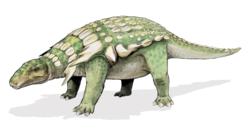Vertebrate paleofauna
Dinosaurs
Color key
| Notes Uncertain or tentative taxa are in small text; |
| Dinosaurs of the Almond Formation | ||||||
|---|---|---|---|---|---|---|
| Genus | Species | Location | Stratigraphic position | Material | Notes | Images |
Indeterminate | Represents a new genus and species of unnamed ceratopsid |      | ||||
Indeterminate [5] | ||||||
Indeterminate [5] | ||||||
Indeterminate [5] | ||||||
Indeterminate [5] | ||||||
P. lacustris [5] | ||||||
| Saurolophus [6] | S. sp. | One specimen (AMNH 3651) consisting of partial cranial and postcranial remains, as well as skin impressions | ||||
Indeterminate [7] | ||||||
Unnamed chasmosaurine ceratopsid [8] | Unnamed | Misidentified as Anchiceratops , it is actually a new species of Pentaceratops -like form that is the sister taxon to Bisticeratops . [9] Holotype was discovered in 1937. | ||||
Other vertebrates
Non-dinosaur vertebrates found in the Almond Formation include crocodyliforms (indet.), turtles ( Adocus cf. and Basilemys cf.), and ray-finned fish (Ichthyodectidae indet.). [10]